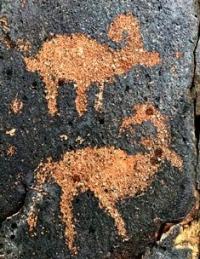Вы здесь
Zheltau petroglyphs.

Archaeological monuments of the Karaganda region.
“He who conquers himself is the mightiest warrior”
Confucius.
Historical sights of the Karaganda region.
A group of Zheltau petroglyphs is located in the Saryterek rural district 3 kilometers south-east of the village of Begazy, 18.5 kilometers east of the village of Saryterek, 15 kilometers north-east of the village of Aktumsyk, 5 kilometers from the Tokyrauyn river, 680 meters west of the Zheltau wintering on the left bank of the Zhinishke River in the Aktogay district of the Karaganda region.
Petroglyphs are located on the southwestern slope of the mountain system of the same name on the spurs of two small hills elongated in the latitudinal direction. There is a strong destruction of the rocky outcrops that form the structure and microtopography of the complex.
In the technique of petroglyphs execution, continuous shallow, fine-point knocking prevails, in some cases traces of scratching are recorded. Drawings on the contour a bit. The cliff pathinization level is 3 - 4. The petroglyphs themselves are very poorly patinated.
Altogether, 20 plates with 130 petroglyphs were found, among which images of mountain goats / rams (36.5%) and horses (9.5%) predominate, roe deer (4%) and predators (1.5%) are found, individually represented deer and bactrian camel. It is significant that in the Zheltau petroglyphs there are no images of bulls, which are, as it were, a marking image of the Bronze Age.
The horses are drawn very simplistically: a straight line of the body, head and tail are often lowered down, four straight legs are shown. Despite some schematism in the engraving of other animals, they are represented much closer to nature and with great expressiveness.
On one of the planes there is a very rare image of a lizard next to a mountain goat, which differs in the manner of execution: larger, more realistic, more dynamic. Judging by the degree of patinization, these images are the oldest on this monument.
Plate 1 captures fifteen argali around a symbolic image resembling a spreading acacia similar to that currently growing near a rocky exit in this gorge. Anthropomorphic characters are represented by horseback riders and in one case on a two-humped camel.
The scene of hunting mountain rams, roe deers and deer stands out in which the main character - the horse archer - is depicted very realistically: a man is shown waist-high and turned back, armed with a large complex bow with an arrow.
Another multi-figure composition shows a man with a chicken, which connects with horses located on this plane vertically, unlike other animals transferred in a horizontal plane. Of interest are schematic anthropomorphic images that can be considered as “sun-headed” characters: over the head of a person drawn in a face, several large points "nimbus" is shown.
In one case, the hands of such an anthropomorph are spread out, the legs are apart, the phallus is drawn, in the other, the image is detailed by drawing the palms and fingers. This conditional manner of transmitting the image, perhaps, testifies to its late origin in comparison with the canonical image of “sun-headed” deities dating from the Bronze Age, and indicates the continuity of traditions and specific Saryarkin images on the rocks in different historical periods.
Zheltau petroglyphs are chronologically correlated by researchers with the Late Bronze Age and the Early Iron Age. It is possible that some of the images belong to the Middle Ages (Beisenov et al., 2012, p. 259 - 274).
Authority:
M.V. Bedelbaeva, V.A. Novozhenov, N.V. Novozhenova. "Fine monuments of the Kazakh small hills". Karaganda State University named after academician E.A. Buketova. Saryarka Archaeological Institute. Karaganda. 2015.
Photos
Alexander Petrov.







